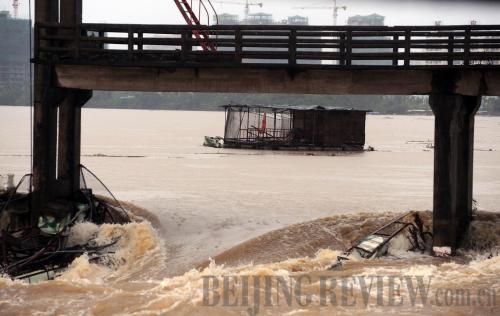|
 |
|
A DANGEROUS RIVER: A raft floats in Wanquan River, Hainan Province, on October 16. Affected by heavy rainfall, the water level of the Wanquan River has risen above the alert line (MENG ZHONGDE) |
The NMC issued an orange alert, its second-highest storm level, for strong winds on October 17, warning vessels to return to port and urging local authorities to prepare for emergency conditions.
The provincial meteorological center in Hainan had issued red alerts, the highest level, for four cities and counties, including Haikou, while an orange alert was issued for six cities and counties, and the orange alert for Tunchang County was upgraded to red on October 17.
Devastating storms and surging water levels throughout the province posed serious challenges for flood control authorities.
More storms
Wei Liucheng, Party Secretary of Hainan, and Luo Baoming, the Provincial Governor, had given top priority to the safety of reservoirs and issued instructions for evacuating residents who live downstream from them.
With the flood situation still worsening, Hainan faced further rainstorms with the approaching super typhoon Megi, the 13th typhoon this year.
Megi brought winds of up to 260 km per hour, making it the strongest typhoon to have appeared in the northwest Pacific Ocean since 1990 and the strongest globally for the year, according to the NMC.
It entered the South China Sea on the night of October 18 and intensified into a super typhoon on October 19.
 |
|
FIGHTING TOGETHER: People carry wooden piles to consolidate the dyke of Zhuli Reservoir in Lingshui County, Hainan Province, on October 18 (GUO CHENG) |
The heavy rainfall in Hainan has made many local rivers, including two major rivers, Nandu and Wanquan, running with water levels higher than their warning marks and more than 70 percent of its reservoirs facing risks, according to the provincial flood control and drought relief office.
But the extreme weather is not the only culprit. Poor construction work and lack of maintenance of reservoirs on small to medium-sized rivers, as well as weak preventive measures are also to blame, experts say.
On October 12, the Ministry of Land and Resources made an announcement to tighten controls on several thousand small and medium-sized rivers that it thinks pose a flood risk in a move to prevent more disasters triggered by mountain torrents.
Financial input
To prevent casualties from disasters and to hold losses to a minimum, the State Council has come up with measures to improve river management and an overall plan is expected before March 2011. Hundreds of billions of yuan will be spent on the project, Du Ying, Deputy Director of the National Development and Reform Commission, told a recent State Council Information Office news conference.
The plan calls for reservoirs with a capacity of less than 1 million cubic meters to be reinforced within three to five years, according to Jiao Yong, Vice Minister of Water Resources.
Jiao said China has spent 64.9 billion yuan ($9.5 billion) reinforcing more than 2,000 large and medium-sized reservoirs and almost 7,000 small ones since 1998 .
But, that still leaves tens of thousands of small reservoirs needing repairs, Jiao added. Before 2012 China plans to fix another 5,400 with capacities of 1 million cubic meters to 10 million cubic meters.
Waterlogged roads and seawater encroachment revealed problems in Hainan's urban planning and construction. For example, the municipal drainage system in Sanya is obviously out-of-date, with few proper drainage channels under most sections of the highways in the city, Wu said.
Besides, Wang Yong, Mayor of Sanya, expressed that the ineffective communication between relevant departments and lack of overall plans were also obstacles in the way of disaster relief and rescue efforts. Now, the Municipal Government of Sanya is making efforts to arrange reconstruction plans, including changing the urban drainage system and establishing a disaster emergency system.
Yang Xuexiang, a professor with the College of Geo-exploration Science and Technology of Jilin University, warned that many cities in China currently have problems with their urban drainage systems, either with aging pipelines that frequently become blocked or scanty drainage construction.
Moreover, with global climate change, previous standards and systems for disaster prevention are apparently not enough. As experts advised, cooperating and sharing the workload reasonably among relevant departments will be key to reducing losses in times of disaster and in dealing with the extreme climate changes in the future.
Heavy Rainfalls in Hainan
September 30-October 9
Affected population: 2.5 million
Evacuated population: 447,000
Direct economic losses: 1.13 billion yuan ($165.45 million)
October 14-18
Affected population: 2.08 million
Evacuated population: 139,300
Direct economic losses: 1.52 billion yuan ($222.55 million)
(Source: Xinhua News Agency)
| 